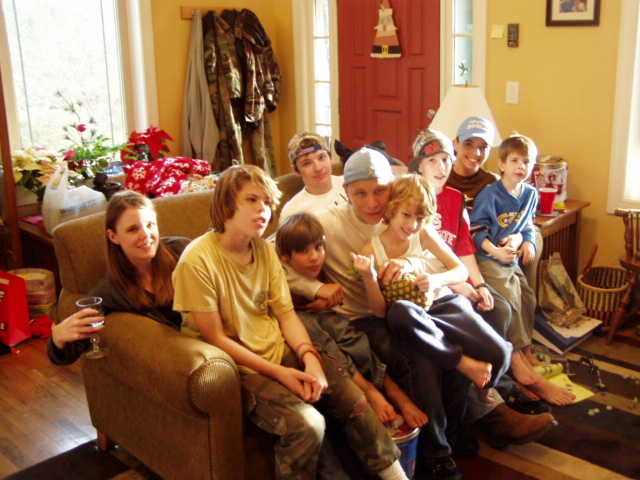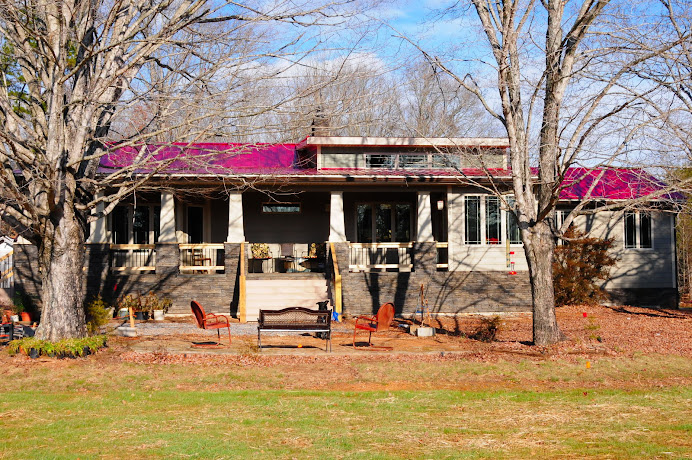Baking a Cake: Why it Took Four Pans for a One-Layer Cake
For more years than I care to count, the joke in my family has been that cakes are always served in the pan – frosted, but on top only. One birthday, Jen asked me for brownies, as they’re always better straight from the oven, sliced and taken right out of the pan. I complied.
While on sabbatical this semester, I’ve done more cooking than in the past 20 years, so as John’s birthday approached, I decided to bake a cake from scratch – one that came from a cookbook that would have special meaning for him. As angel food is his favorite, I first looked for that recipe, but 12 egg whites seemed like a lot for a cake that only three people would eat. Then I came across a one-layer sponge cake recipe, handwritten and saved in an envelope addressed to his great-grandmother, Emma Lavinia Elliott Borneman, and placed under the “cakes and pies” tab in his grandmother’s recipe box. This seemed the cake to make, and with just five ingredients, how difficult could it be?
The receipt – as it was spelled in the 1800s – called for 1 cup of sifted cake flour, 1 cup of granulated sugar, ¼ teaspoon of cream of tartar, 6 eggs, either vanilla or lemon extract for flavor, and a lemon or orange drizzle topping made with confectioner’s sugar, butter and milk.
“Success in this cake depends on beating after each ingredient is put in,” the receipt-writer instructed.
“I can do this,” I thought and got out all the ingredients -- measuring spoons and cups, several bowls, and the sifter. Because I had all-purpose flour, not cake, I researched what to substitute, discovering that replacing 2 tablespoons of the flour with 2 tablespoons of cornstarch would provide the added protein that makes cake flour different.
The first task was separating the egg yolks from the whites, something I wished I’d had a separator to do for me. Luckily only two tiny pieces of eggshell wound up in the whites, which were to be “beat until stiff” before the tartar was added, then both ingredients “beat lightly.” Sugar “sifted until fine grain – about four or five times” followed and the mixture was “beat again.” Next came the egg yolks – “well beaten” – and lastly, the sifted flour. “Beat again and flavor with lemon or vanilla extract.”
I did as instructed, making a powdery mess sifting the cornstarch into the flour and the sugar until it was a “fine grain.” But I felt good, proud of my undertaking. John was going to love this, and surely if I lightly oiled and floured the pan bottom, the cake would come out.
The last step of pouring the batter into the pan seemed simple, until I looked at the receipt and realized it called for a funnel pan. We have square and round and heart-shaped and bundt pans, but I’d never baked in a funnel pan. Then I remembered that one of the “finds” John brought home as he and his brothers have sorted through their late mom’s belongings was an aluminum cake pan with a funnel insert. Though I’d pooh-poohed keeping it, he had washed, dried, and put it away, so out it came.
Now, I’d seen cakes baked in such a pan, but would the way the funnel fit into the base truly not leak? I poured the batter in, then thought I should check for leakage, and with that, I grabbed the funnel and lifted it before …. Duh! I’d broken the seal and batter was oozing out the bottom onto the counter and down the cabinet to the floor. Talk about a sticky mess.
Grabbing a round cake pan from the cabinet, I set the dripping funnel in it and poured the remainder of the batter into the pan, then set it on the counter. Now its bottom was sitting in batter. So I got another round pan, put it under the first, and carried everything to the stovetop. Carefully lifting the funnel and the first pan, I poured its contents into the second, and spilled yet more batter onto the stovetop and around the edges of the pan. Good grief. I reached for one more cake pan -- non-stick -- and again poured the batter. Done, but now my hands were sticky, too!
It’s lucky I was home alone, because my careful planning had quickly fallen apart, literally. If anyone had been there . . .
Finally I got the cake into the oven. I’d had to check the back of a prepared cake mix box for the proper temperature setting – 350 -- because the receipt called for an oven whose flame had been turned “comparatively low” immediately after lighting.
“Don’t open oven for 20 minutes,” admonished the receipt writer. “By this time cake should be well risen and turning brown. Lower flame and bake almost 15 min. longer.”
If you do any baking, you can probably imagine the rest. The 350 was too hot, the cake never rose, and at the end of 35 minutes, though it was golden brown, it was just a half-inch thick. The toothpick test revealed a done center, however, so out it came. I let it sit for 10 minutes, turned it upside down on a cake rack, and waited and waited and waited.
It did not fall.
With a knife, I carefully went around the edge of the cake until it was loosened enough from the side of the pan to -- finally -- pop out. Success!
That night, I served John his birthday cake, telling him the story of finding his great-grandmother’s recipe so it would be special. My nephew Jack rolled his eyes and John fought back laughter as I shared my baking adventure.
“It’s not much of a sponge cake,” I said, slicing into what was the consistency of a biscuit. “But it came out of the pan.”
skip to main |
skip to sidebar


Cousins

Finished!
After 40-years in News & as an Assoc. Prof. of English at Wake Tech in Raleigh (NC), Harmony-resident Suzy Barile is retired. A graduate of St. Mary’s JC & UNC-Chapel Hill, she earned a master’s degree from NC State. Signed copy of the award-winning “Undaunted Heart: The True Story of a Southern Belle & a Yankee General” is $21. Contact suzyb3@gmail.com. Barile is co-editing the papers of NC’s Revolutionary War-era governor Richard Caswell. Follow Ella Swain - @EllaHSwain
Suzy Barile

Undaunted Heart: The True Story of a Southern Belle & a Yankee General
Order my book -- Attend Programs
Undaunted Heart: The True Story of a Southern Belle & a Yankee General
Keep up with Ella Swain and Genl Atkins through Twitter -- @EllaHSwain.
Interested in having Suzy Barile speak to your group? Contact her at suzyb3@gmail.com.
Here are upcoming dates to remember:
WATCH Suzy Barile on The Artist's Craft at http://www.youtube.com/watch?
WATCH Suzy Barile on WUNC-TV's Bookwatch at http://www.unctv.org/ncbookwatch/author_az/2010/Suzy_Barile.html
INVITE Suzy Barile to speak at your neighborhood Book Club, your school, your community organization.
Keep up with Ella Swain and Genl Atkins through Twitter -- @EllaHSwain.
Interested in having Suzy Barile speak to your group? Contact her at suzyb3@gmail.com.
Here are upcoming dates to remember:
WATCH Suzy Barile on The Artist's Craft at http://www.youtube.com/watch?
WATCH Suzy Barile on WUNC-TV's Bookwatch at http://www.unctv.org/ncbookwatch/author_az/2010/Suzy_Barile.html
INVITE Suzy Barile to speak at your neighborhood Book Club, your school, your community organization.
Check the www.enopublishers.org site for additional upcoming readings.
About Me
Christmas 2011

Cousins
Harmony House
Finished!



